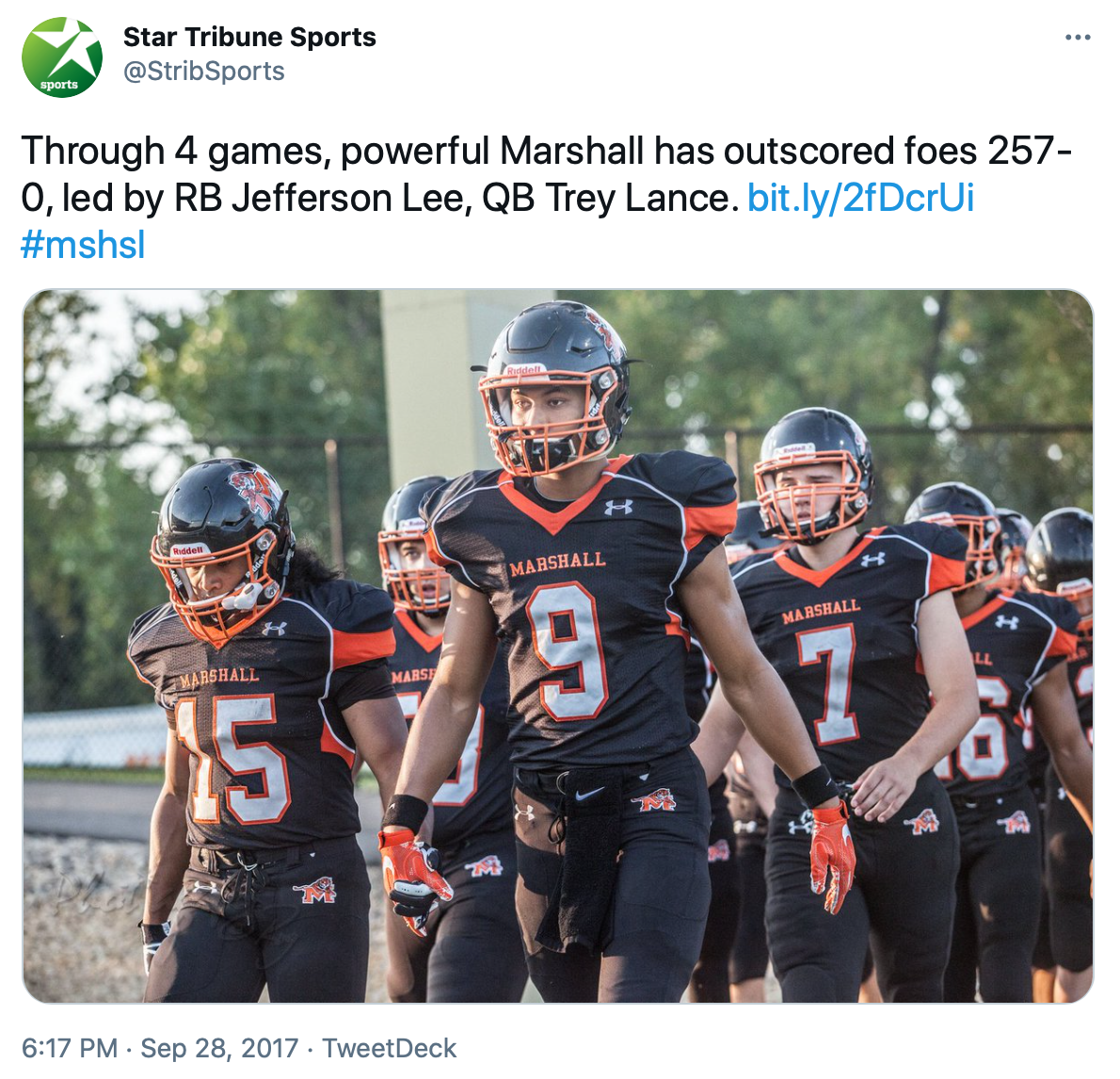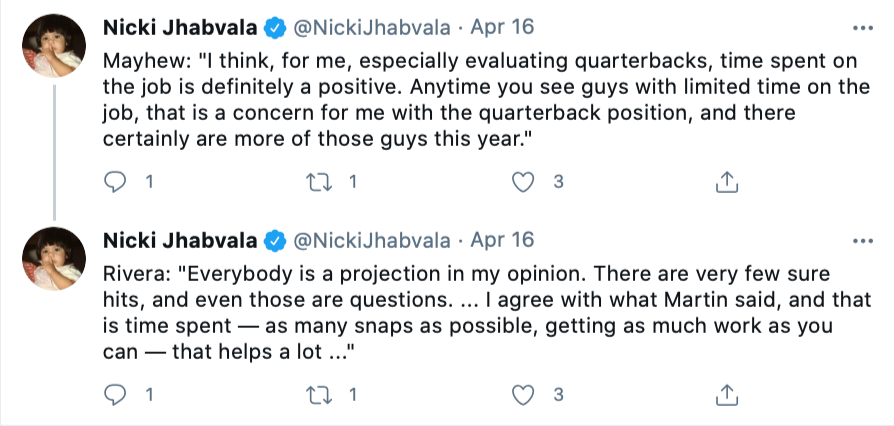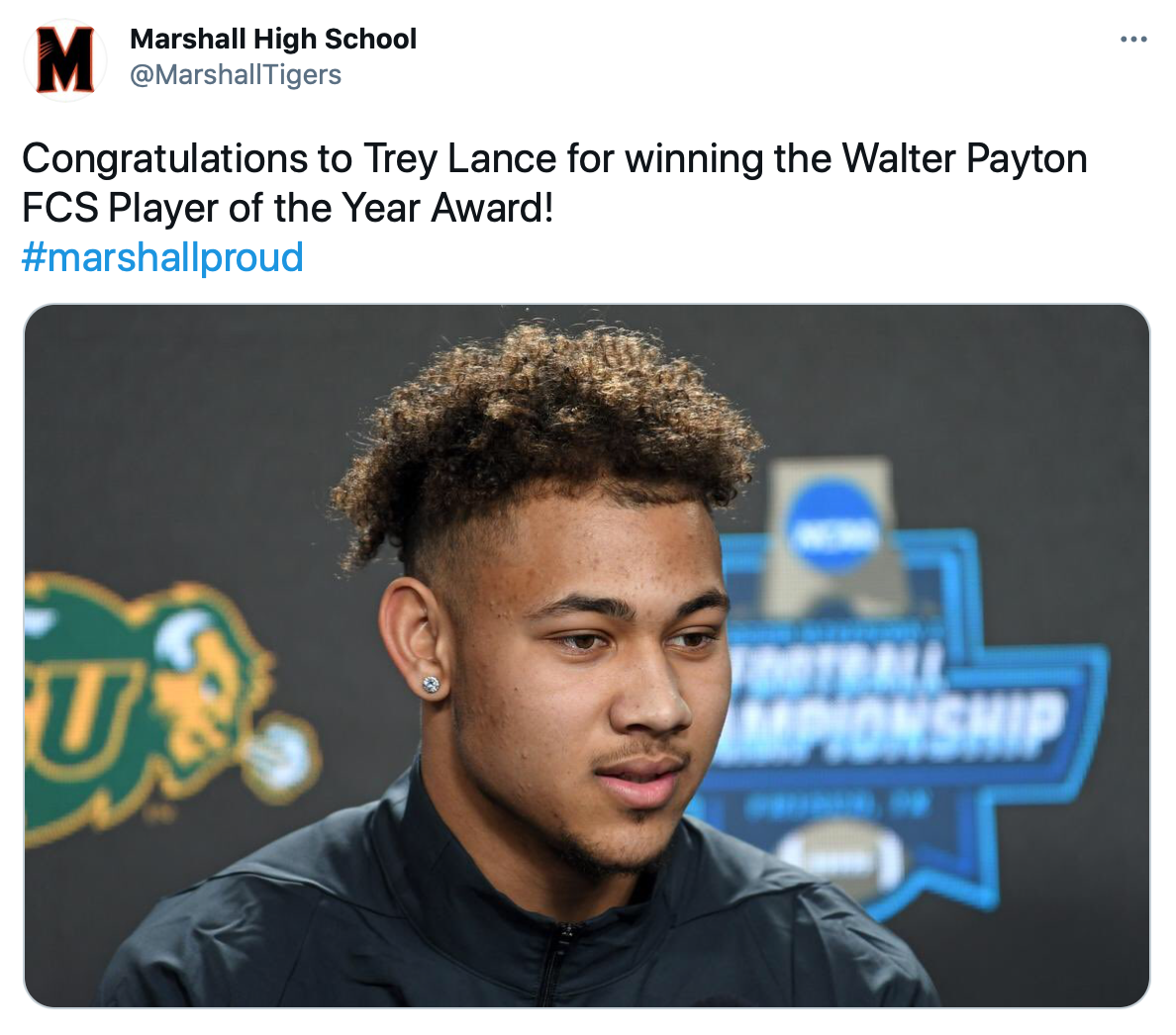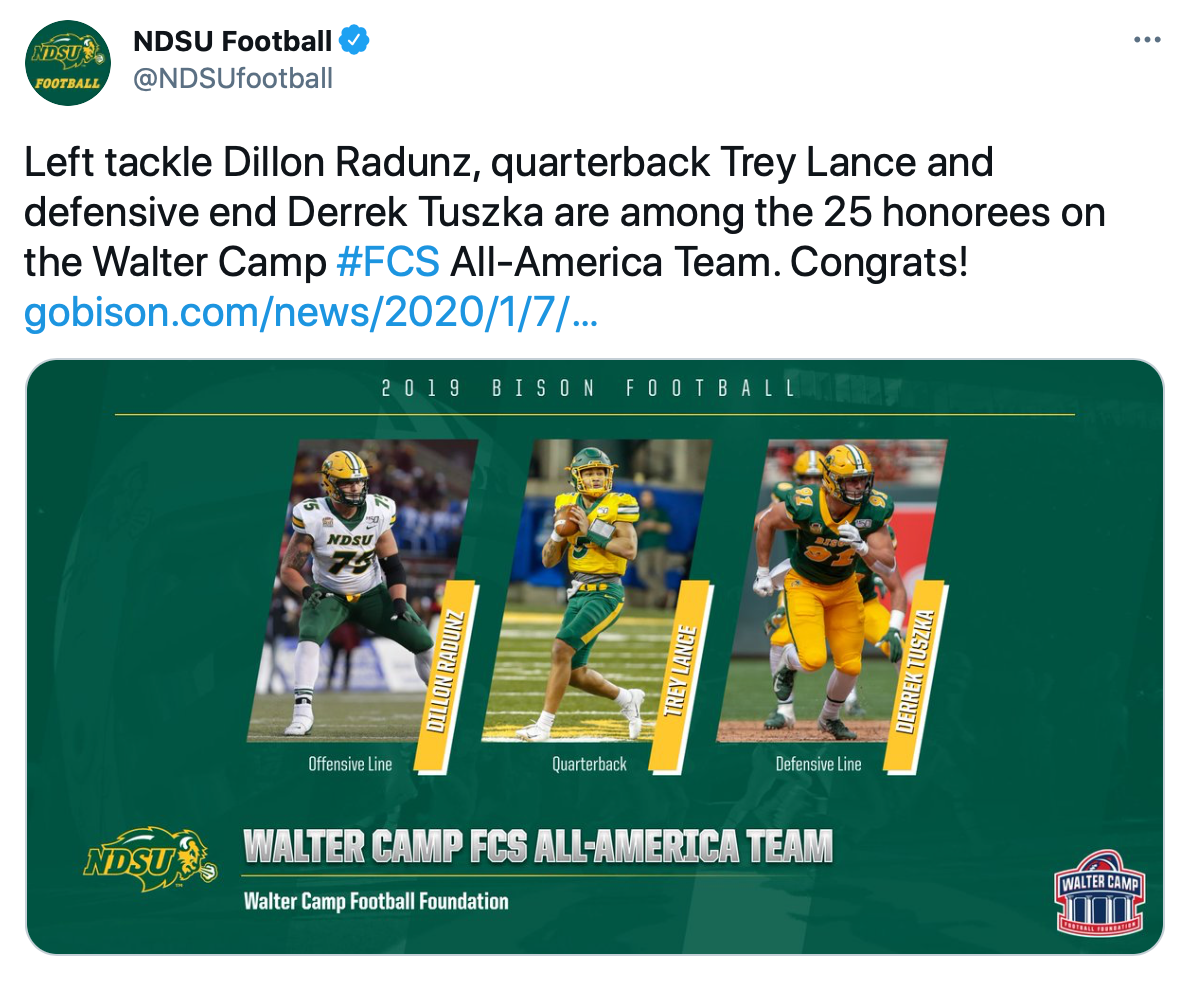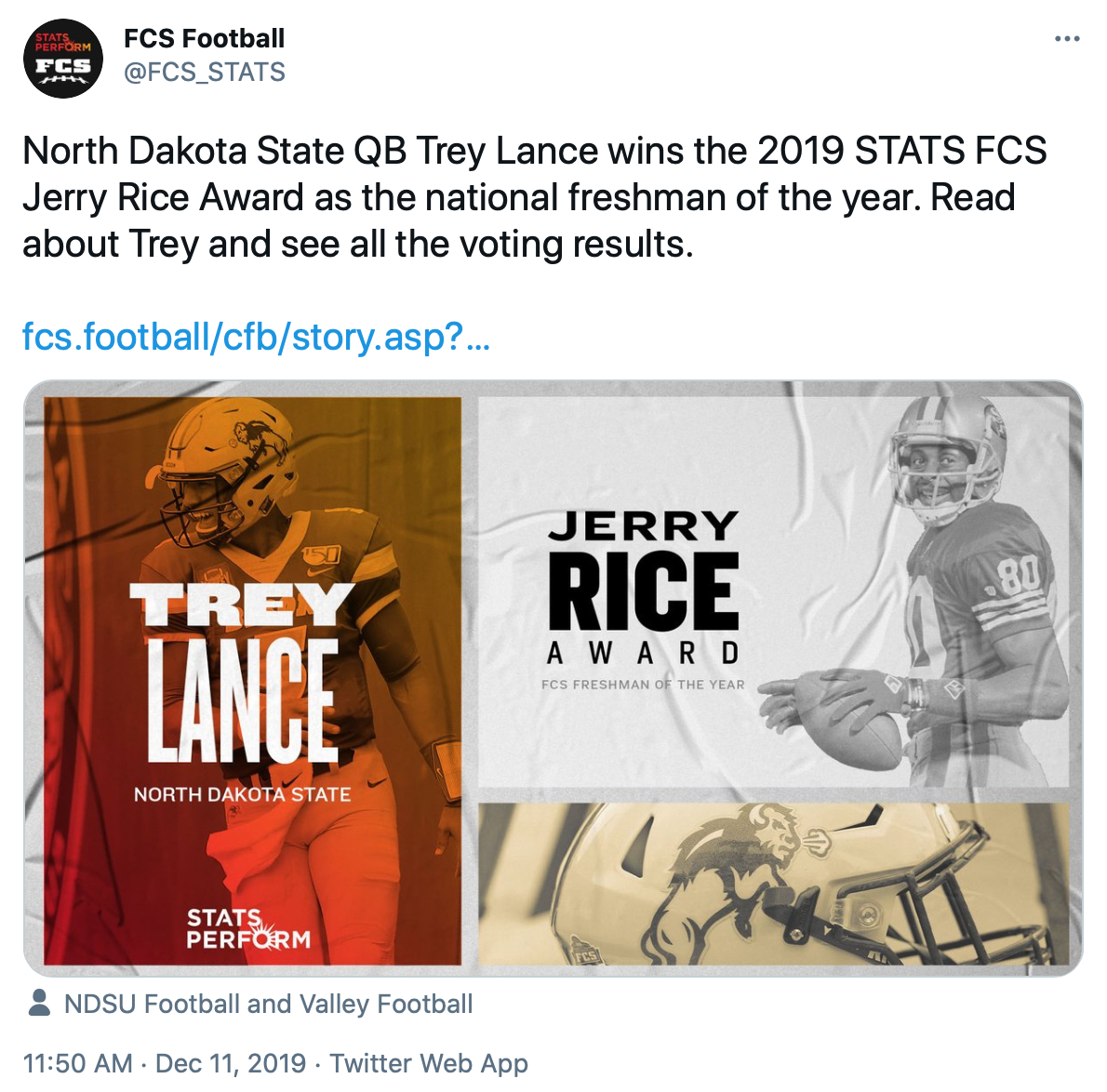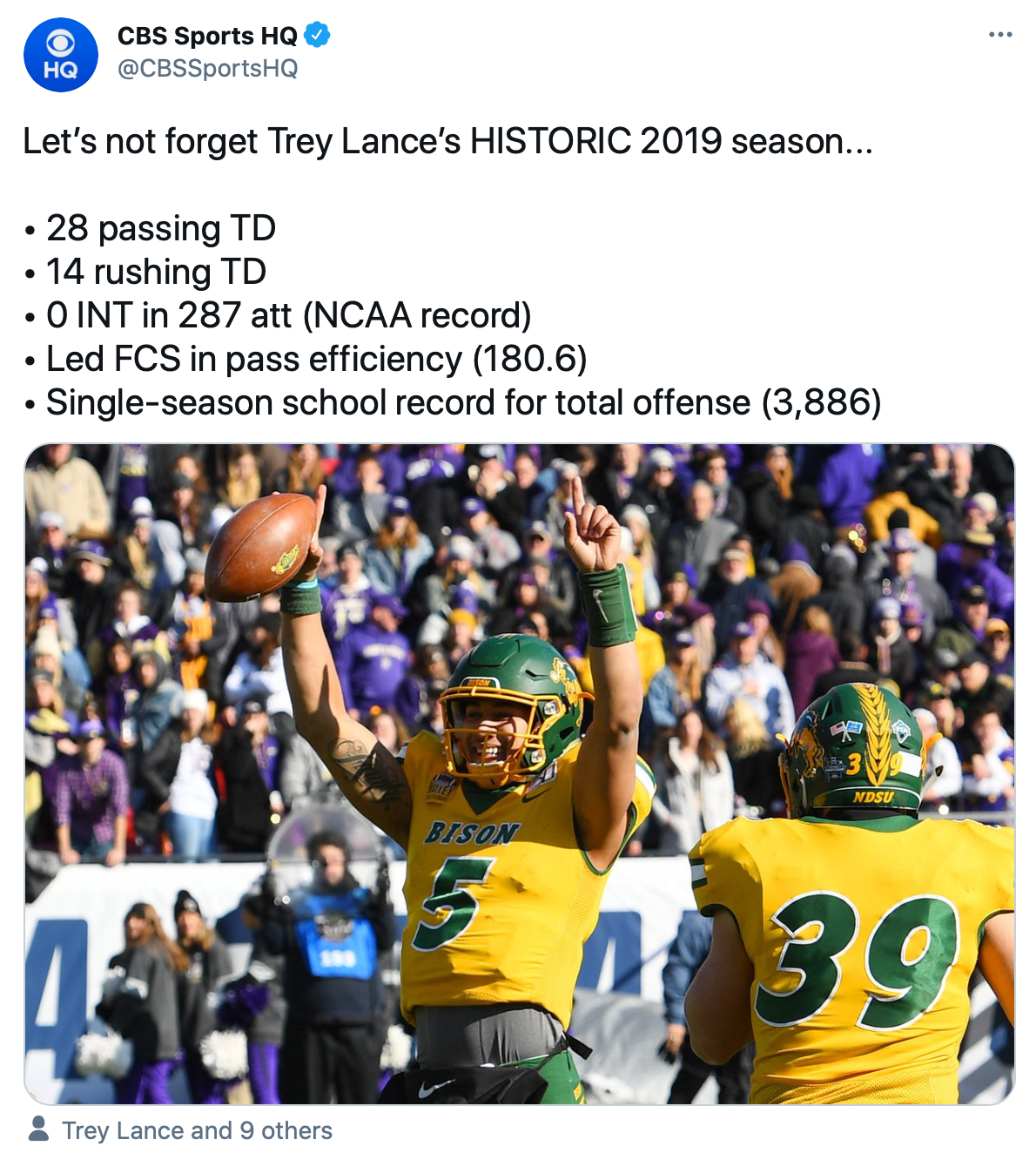Trey Lance
QB | North Dakota State Bison | 6-3 7/8 | 224 lbs.
NFL QB Expectations
Over the last three NFL seasons, QBs have been tasked with targeting their receivers on three particular patterns at a higher rate than those sexy Go routes. The most frequent of which is the Out — 18% more than Gos. Not to be confused with the Speed Out, you can distinguish between the two by the squared-off break — a hard cutting 90° angle for the traditional Out. The second most frequent route — 12% more common than Gos — is the Hitch (also referred to as a “Curl,” “Hook,” or “Stop”). Next, we have the Crossing pattern — 11% more — where the receiver will drive toward, cross midfield at various depths. While these three routes may not elicit the same level of viewing excitement as the beloved Gos, the third-level work accomplished by the deep targets are entirely dependent on the underneath patterns keeping secondaries honest. To close out the most important routes required by the NFL QB to master, we have the collection of routes I will refer to as Flatwork (Speed Outs, WR Screens, and Slide routes). These will most often involve Slot WRs and TEs working at a depth within five yards of either flat. These five patterns account for over 75% of the average route profile for NFL QBs.
The Story
Trey Lance only started learning the QB position as the backup for Marshall Middle School in Minnesota because the team needed him. Mostly, he played RB on the offensive side in youth ball. But his father, Carlton Lance, taught him to view the game from both sides of the ball. Carlton played cornerback collegiately for Southwest Minnesota State, and went through training camps with the Houston Oilers and San Francisco 49ers. He concluded his playing career with a season in the CFL for the Saskatchewan Roughriders (1993), and one in the World League with the London Monarchs (1995). While I’ve been unable to locate anything online substantiating the position, Carlton also returned to SMSU as its defensive coordinator in the early 2000s.
Fast forward to 2013, and Carlton is coaching Marshall Middle during Trey’s eighth-grade year. It was during that season where Trey’s indoctrination at QB began. It’s truly remarkable that Trey was able to propel his game to a likely top-10 selection in the 2021 NFL Draft within eight short years with basically only his father for guidance and coaching. (Coincidentally, another QB that will be selected in the first round of this draft, Zach Wilson, worked exclusively with his father for much of his career.)
But what Carlton considerably lacked in his QB coaching expertise and background was replaced with the extensive knowledge of coverages from his playing and coaching days. And young Trey had some of that experience, too — he was a two-way starter in middle school, also playing safety.
Lance played with the Marshall HS Tigers for HC Terry Bahlmann. The Marshall program has a long history of offensive success, with the seasons under Bahlmann, at least, utilizing the Delaware Wing-T attack. It just so happens that Alabama QB Mac Jones, a far different kind of talent, played in the same offensive formation during his Bolles HS career.
The “Delaware” Wing-T was actually invented at the University of Maine in 1950 by HC David M. Nelson. Taking over the same role at the University of Delaware in 1951, Nelson, along with his assistant/successor Tubby Raymond, eventually pushed the offense's popularity into the mainstream. Forest "Evy" Evashevski adopted the Delaware Wing-T at the University of Iowa, and was recognized by the FWAA as winning the national championship in 1958, back when those things weren’t settled on the field.
The essential difference between the Delaware Wing-T and the Triple-Option is shifting one of the players from the backfield to outside of the inline TE — referred to as the Wingback. It provides the offense with additional means to move the ball through the air. It also places its QB under center on a high number of snaps. It just so happens that North Dakota State HC Matt Entz and OC Tyler Roehl utilize a similar offense for the Bison. NDSU positioned Lance in the backfield with multiple RBs on over 45% of offensive plays during his career. Lance also took well over 45% of snaps from under center. Those numbers would be a significant boon to Lance’s NFL future if he were joining the pre-2000 era of the NFL. But while NFL QBs are under center far more than most of their college counterparts, those numbers are shrinking. During the 2020 season, NFL teams used multi-RB backfields on around 12% of offensive snaps, and their QBs from under center on around one-third of snaps.
Under center or in the shotgun, Lance has won a lot of games at a lot of levels. The Lance father-son duo led their eighth-grade middle school team to an undefeated record. Trey received his first game snaps in HS during the final regular season contest against Belle Plaine in 2015. Filling in for the incumbent starting QB who suffered a dislocated elbow, Lance immediately drove his offense into scoring position. However, he concluded the drive with an INT to lose the game. Following the defeat, Lance led his team to a 20-3 overall record during the rest of his career, with all three losses coming in the Minnesota state playoffs. He also overcame that game-losing INT to lead Marshall HS to its first South Central-Red Championship in 24 years. He guided his school to three consecutive Class 4A Minnesota state tournament appearances.
Lance was contacted by QB Coach & Passing Game Coordinator Randy Hedberg the summer before his junior year at Marshall. Lance was drawn to the Bison due to their winning culture, detailed outline describing how they’d utilize him. However, the day before he signed his letter of intent with North Dakota State (12/20/2017), the combination of former Boise State HC Bryan Harsin, OC Zak Hill, and Director of Recruiting Darren Uscher contacted him aggressively attempting to flip his decision to Boise. Lance stuck with his commitment, and all signs point to Lance making the correct decision. Lance led NDSU to the first 16-0 finish in college football since 1894, attempted the most passes in a season without an INT (287) in NCAA all-division history, and set the NDSU record for total offensive yards in a single-season (3,886) in 2019.
With his draft stock already rising based on his 2019 film, Lance made the questionable decision to play in only one game during the 2020 season. He faced off with Central Arkansas in a glorified fall exhibition — NDSU played its full season during the spring, and its contest with Central Arkansas was the only game the Bison played during the traditional fall schedule. Lance opted out of the spring season to prepare for the NFL Draft.
That performance had questionable passing results for Lance. But he added 143 rushing yards against the Bears, with a pair of TDs. With only one full season of college experience at QB, you can guarantee that every single team that considers selecting Lance will spend multiple nights tossing and turning in bed, wrestling with the decision. How many teams view Lance’s opt-out a negative? Look at Washington, which recently bypassed sending representatives to attend Lance's second Pro Day. It was a decision made after GM Martin Mayhew and HC Ron Rivera made the following comments:
The reps would be invaluable for Lance, given he’s the least experienced of the top QBs in this class. But for context, had Lance made the decision to play, he would be facing off with Eastern Washington in the first round of the FCS Playoffs this upcoming Saturday (April 24). He’d be drafted before his college career would have been over!
On the one hand, Lance certainly feels that what he put on tape during the 2019 season should be proof enough of his potential and he didn’t want to get hurt. On the other, he bypassed a prime opportunity to shine in a truly rare spotlight, drawing primary representatives from all 32 NFL teams. It’s an opportunity for attention I’d guess other draft prospects would bend over backwards to have.
The Attributes
Despite his high school’s impressive results, Lance’s passing left a lot to be desired. It’s not a surprise whatsoever that Lance chose not to upload a highlight reel from his sophomore year. He did provide footage from his junior season on Hudl. Attempting to track down injury information from high school athletes is a fool's errand, but Lance did miss at least two games in 2016. A lingering injury is likely the best explanation for only rushing for 274 yards that season. He did return to play two games during the 2AAAA Tournament, completing 48% of attempts, and 7.9 YPA. But Trey didn’t carry an injury into the same tournament during his senior season. In two games, Lance completed 33% of attempts, to go along with 4.7 YPA. He did add an average of 123 YPG rushing, and two TDs/game. During his HS playoff career, Lance only completed 47.4% of passing attempts. If you are unaware, you simply cannot teach accuracy!
The Big-Three of the prep scouting circuit (ESPN/247Sports/Rivals) did not feel Lance possessed traits for Power Five ball. ESPN and Rivals left him completely out of their Dual-Threat QB rankings. 247Sports slid him in as a three-star talent as its QB49. With so much of his NFL potential riding on his rushing ability, we need to pay particular attention to the results from his prep testing. He ran the 40-yard dash at 4.60 seconds, a time that would rank him in the 89th percentile among NFL Combine QBs over the last eight seasons. As we’ll see in his NDSU tape, Lance is much faster than he is quick. His 4.51-second short shuttle (17th percentile) is a perfect representation of his lateral immobility. He added a 32.4-inch vertical (54th percentile) to his pre-college athletic profile.
North Dakota State (2019-2020)
W1 vs. Butler | W2 vs. North Dakota | W4 vs. UC Davis | W7 vs. Northern Iowa | W8 vs. Missouri State | W9 at South Dakota State | W10 at Youngstown State | W11 vs. Western Illinois | W12 vs. South Dakota | W13 at Southern Illinois | FCS Quarterfinals vs. Illinois State | FCS Semifinals vs. Montana State | FCS Championship vs. James Madison | W5 vs. Central Arkansas (2020)
(Quick note: the easiest way to view these games from YouTube — while also avoiding the ads — is to download the files using a YouTube Downloader. My recommended media players are QuickTime (Mac) or VLC.)
Per the usual, I’ve added links above to the games where Lance offered us the best clues to his future. However, in order to provide analysis on as many prospects as possible before the draft, I’ve decided to change up the formula. I’ll forgo the rigorous breakdown of Lance detailing each important game from his career in favor of pointing out the exact same characteristics from a general perspective. But nothing in my process will change on the back end. My analysis will still be entirely based on the study of Lance’s film, supplemented by the numbers.
An unmistakable trend emerges from Lance’s first season in green and yellow. With two examples from the Butler game in Week 1, Lance benefited from two busted coverages (43:34 & 1:10:23 in the footage) to collect a pair of TD passes. In total, 8-of-30 (27%) of Lance’s career TD tosses were collected with wide-open receivers running free due to coverage busts. In comparison to the coverage bust TD rate of the other top QBs in the class: Trevor Lawrence (9%), Justin Fields (16%), Zach Wilson (13%), Mac Jones (9%), Kellen Mond (12%), and Davis Mills (17%). Both of those coverage bust TDs benefited from Butler bringing a blitz.
We also receive swift examples of Lance’s biggest fantasy draws: his ability to use his legs on a 34-yard TD (10:41), and his big arm on a 54-air yard TD bomb (17:43). Lance throws another TD in the face of a blitz at 57:59, but it’s an example where the Bulldogs actually got home to apply pressure on Trey — easier said than done. We’ll use the North Dakota game to highlight the intended point. The Fighting Hawks sent the highest number of blitzes (14) that Lance would see all season. They managed to sack Lance on three, and apply pressure on six. Both numbers stand as season high’s. In fact, those three sacks were 21% of the season total, and 16% of the total on the six pressures. One blitz backfired in their face, sending the house after Lance. On the play, LCB Jordan Canady handed Lance another busted coverage TD after biting down on the run fake (50:18).
Despite the success of North Dakota, the NDSU O-line tucked Lance into a cozy pocket in 2019. The Bison O-linemen were only responsible for their QB being touched eight times all season. The only O-line from the 2020 that came close to that number for top QBs from the ‘21 class was the BYU O-line for Zach Wilson (12). It’s the one measure where the Alabama O-line didn’t lead the pack. Lance benefited from an O-line that would only permit 28% of blitzes to pressure his pocket. Compared to the ‘20 rates for the other QBs: Jones (25%), Wilson (29%), Mond (36%), Mills (36%), Lawrence (36%), and Fields (41%). Considering Lance and Wilson faced competition outside of the Power Five conferences, it’s really not that shocking of a revelation.
Also reminiscent of BYU, the North Dakota State O-line was/is stacked with NFL talent. Lance was tucked in at night by LT Dillon Radunz, RT Cordell Volson, LG Nash Jenson, RG Zack Johnson, and C Karson Schoening. You can even expect to see backups Cody Mauch, Jalen Sundell, and Grey Zabel in an NFL uniform in another season or two. Matriculating to NDSU from a Wing-T offense in HS, Lance does not take a subtle approach to his ground work. Rather than striving to protect his body from unnecessary shots, he runs directly into contact. It’s the opposite approach that we see from Lawrence and Fields. But it’s the same approach seen from Wilson. Only 18% of Lance’s career rushing attempts were the result of scrambling away from the play design. The vast majority of his rushing totals were collected on by-design carries.
In January or February of 2020, prior to the effects of COVID-19 spilling over onto college football, Lance had “lower body” surgery to repair an injury he suffered in HS. It’s likely the culprit forcing him to miss those games mentioned earlier during his high school junior year. And you can be certain the injury was picked up while running the ball.
We’ll use the South Dakota State game from Week 9 to focus our attention on my next concern in Lance’s future. Lance ran into a Jackrabbits’ defense that countered his skills with a physical run defense. He carried the ball on 39% of his total offensive snaps — a Derrick Henry-like workload. I’ll dig into the analytics on Lance’s rushing history later in the profile. What needs to be circled in red from this game’s footage is the amount of damage he absorbed to his body. Here is a list of video times for you to see just how much in a single game: 10:10, 13:46, 16:30, 18:11, 38:52 (the only scramble), 45:16, 46:40, 48:43, 1:08:06, 1:09:28, 1:17:42, 1:19:03, 1:24:22, 1:38:17, 1:45:56, and 1:57:26.
Lance obviously provided plenty of positives for NFL teams to take notice. Week 10 at Youngstown State stood out in highlighting Lance throwing a pair of TD passes on Play Action Rollouts. He added a further TD example with straight Play Action. It is very likely that Lance is being mentioned in connection with San Francisco at 1.03 due to hitting 37% of his TDs on only 19% of attempts using Bootleg motion — an important aspect of a Kyle Shanahan offense. Lance didn’t command the action facing any particular coverage type, but he was certainly better than average across the board. The most impressive throws facing Cover 1 (Man) can be found in Week 7 across from Northern Iowa, and he also made some nice ones in Week 15 against Nicholls.
You’ll want to check out the South Dakota game from Week 12 for examples against Cover 4/Quarters (Zone). Look to the FCS Semifinals against Montana State to see what is easily his best work facing Cover 3 (Zone).
With the good, we have the bad. You’ll definitely want to check out the Missouri State (Week 8), Southern Illinois (Week 13), and Illinois State (FCS Quarterfinals) games to see a collection of examples where Lance’s intermediate, and deep accuracy stand out as a concern. On throws traveling at least 10 yards, Lance only completed 46% of attempts. His completion percentage on intermediate throws between 10-19 yards was just a hair above 55%. In comparison, Fields completed 49% of deep throws, 73% of intermediate attempts. Lance’s accuracy also waned on third down attempts (53%), when pressured (44%). The numbers also indicate his massive preference working from a Heavy formation. His passer rating fell by 29%, completion percentage by 17% when passing from a Spread formation. This detail adds another wrinkle to the formula.
Fantasy Fit
Washington, Detroit, Atlanta, New York Jets, and Chicago all utilized high rates of Spread alignments last season among teams in the market for a foundation QB. Most of those teams, as well as Philadelphia, could see significant alterations to their offenses following coaching replacements. The 49ers and Patriots are the two teams that stand out for their considerable use of Heavy personnel. The price San Francisco paid to move up to 1.03 makes little sense for a selection of Mac Jones. He lacks the athleticism, arm strength for that type of investment. The one holdup with Lance as a clear fit for the 49ers comes from Shanahan himself, stating in December that “he is more open to deploying a mobile quarterback as long as sacrificing accuracy and pocket presence are not the trade-offs.”
The Falcons will be under the control of new HC Arthur Smith, whose Titans’ offense used a ton of Heavy personnel last season. However, they do not currently have a Henry-type in their backfield. The addition of Mike Davis also points to maintaining the added offensive spacing. It’s very likely that Atlanta addresses the RB position in the draft. The reason Tennessee utilizes so much Heavy personnel is due to the rare weaponry offered by Henry. It’s not an offensive approach that a franchise sets out to reverse engineer. In addition, Atlanta is loaded up at receiver with Julio Jones and Calvin Ridley who ran over 80% of their routes from a Spread offense the last two seasons.. That leaves us with the Patriots. Only the Ravens employed more designed runs than New England last season. Bill Belichick would likely jump at the chance to select Fields. However, I don’t think Fields will get past Atlanta, if he doesn’t go a pick sooner. The Patriots have let it be known that they are looking to move up for a QB. And their offense is perfectly suited to Lance’s strengths.
The Bottom Line
Obviously requiring painstaking efforts to collect, I charted 81% of NDSU career rushing attempts from Lance where he took significant contact from a defender. Not glancing shots, direct impact hits. In many cases, from multiple defenders. Why is that significant? The NFL Players’ Association provided information around a decade ago that the average NFL career only lasts around 3.5 years. It’s likely that the numbers have altered slightly over time, but the disparity in career expectancy between QBs and RBs has not only been maintained, it’s likely to have widened. For QBs, they are expected to see a career average a little under five years. A RBs shelf life is only 2.8 years, 40% less than QBs. However, those numbers are drawn from all players, not from the players who are on their NFL team’s active roster from Day 1.
It’s common knowledge that RB production falls off a cliff, on average, after their Age 28 season. It’s precisely why NFL teams drag their feet in handing out second contracts to the position. And we can look to the pounding RBs take during their brief careers as the active ingredient leading to their demise. Lance has the frame of a bell-cow RB, combined with the arm strength of Josh Allen. He’ll only be 20.97-years-old on the date of the 2021 draft. So, he is likely to continue to fill out, possibly maxing out at around 240 pounds. Lance joins Fields and Jamie Newman in this class meeting the criteria of weighing at least 224 pounds, measuring under 6’4”. Only 26 QBs invited to the NFL Combine over the last seven seasons match those benchmarks. Of those, only eight have started more than nine games in the NFL. The designed run percentage of those eight QBs over their careers: 30% (far less than Lance’s 80% with NDSU).
The draft capital price of acquiring franchise QBs is simply too much to risk their health on designed rushing attempts. Scrambling away from a collapsing pocket is a different story entirely but, ever then, coaching staffs will expect their QBs to get down/out of bounds, whenever possible. As long as we expect the same from Lance’s future superiors, removing a chunk of his rushing potential will collapse his fantasy floor. If you need an example of RB damage on a QB from modern defenders, Cam Newton is your guy. Newton carried the ball 374 times prior to 2014 with only a minor ankle sprain slowing him up. Over the next five seasons, a series of injuries and surgeries replaced what appeared to be an NFL superstar with the replacement-level QB of today.
Ball accuracy has been a significant issue with Lance dating back to his Marshall HS days, extending onto all throws at NDSU travelling greater than 10 yards. Expecting him to spend an increased amount of snaps in the pocket would place a massive amount of significance onto every throw.
More time in the pocket would also place Lance into additional snaps where he’s not provided by that NDSU clean pocket rate. Can we expect Lance to properly develop at reading the NFL blitz without the benefit of an elite O-line? We really won’t know that answer until it’s too late. Just like Zach Wilson, comps to the path taken by Josh Allen are likely to be used to explain away accuracy concerns, and also on making the successful jump up in competition talent level. First of all, Allen is not a comparison tool, he is an outlier on an island to himself. Projections to aberrations such as Allen are one of the worst mistakes that can be made during the draft process. The name of the game is minimizing investment risk. The player I see from Lance’s tape is the Packers’ 2020 first-round selection, Jordan Love. Nearly identical size, athleticism, and arm strength. Love also possesses some accuracy concerns, and we’ve yet to learn whether he’ll be able to stand up to NFL blitzes.
Don’t allow yourself to be drawn into believing every Group of Five or FCS QB holding a level of potential is the next great NFL cornerstone. Very few hit, the vast majority do not. Since I spend so much of my time strategizing inside the devy format, I’m innately provided with clarity during draft season. When you are drafting from the list of players with additional college eligibility — including incoming true freshmen, you are keenly aware of the odds stacked against players outside of the Power Five (P5). I’ve taken stabs outside the P5 in the past, and ended up being burned on every attempt sans Dallas Goedert. (And I even drafted Lance in a Devy Superflex consisting of friends from PFF last season.) I would venture to say that my bust rate on selections from the P5 falls below 10% in well over a decade of Devy experience. The culmination of the film and analytics I’ve detailed confidently places Lance as my Dynasty QB4 behind Fields, Lawrence, and Wilson.


